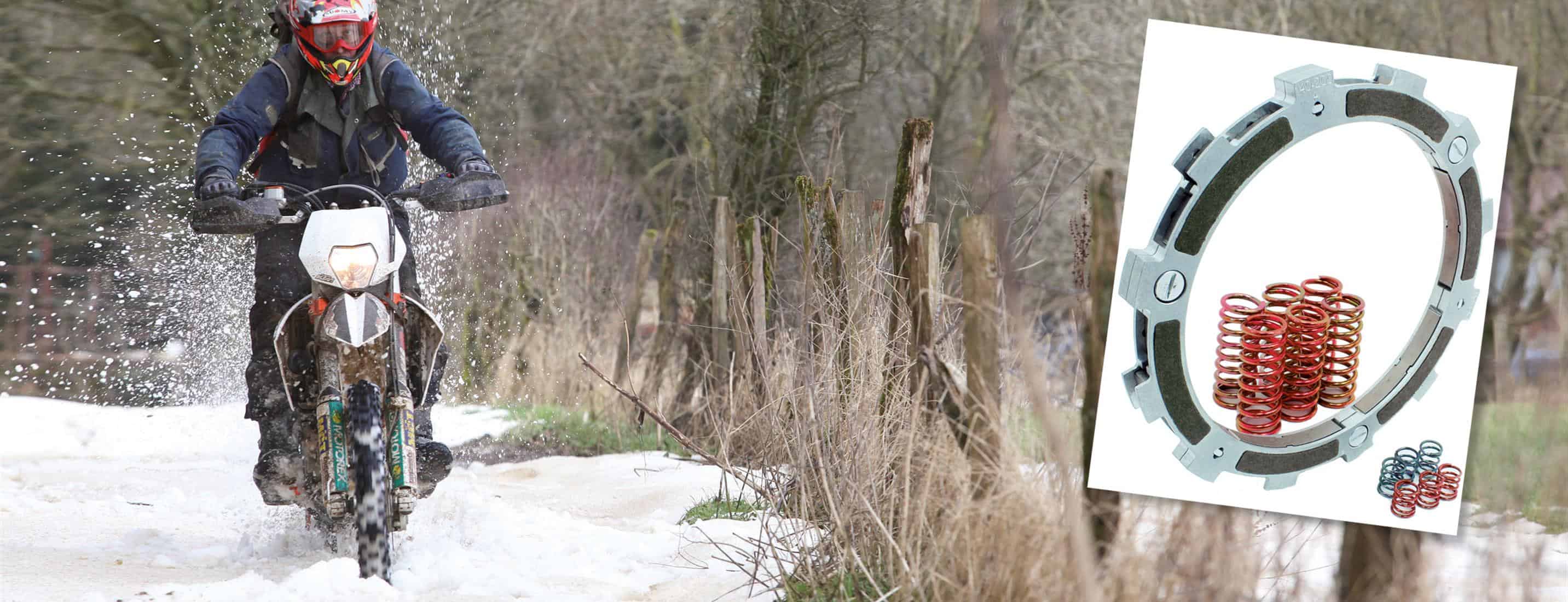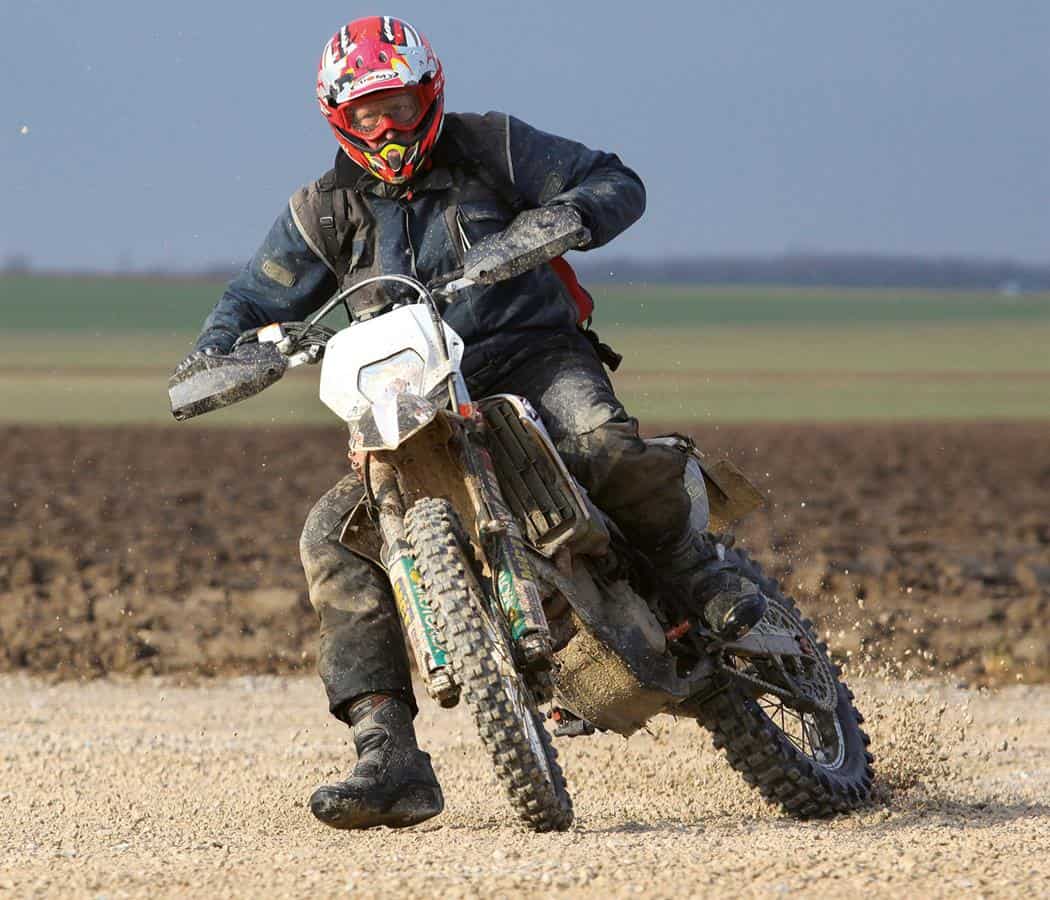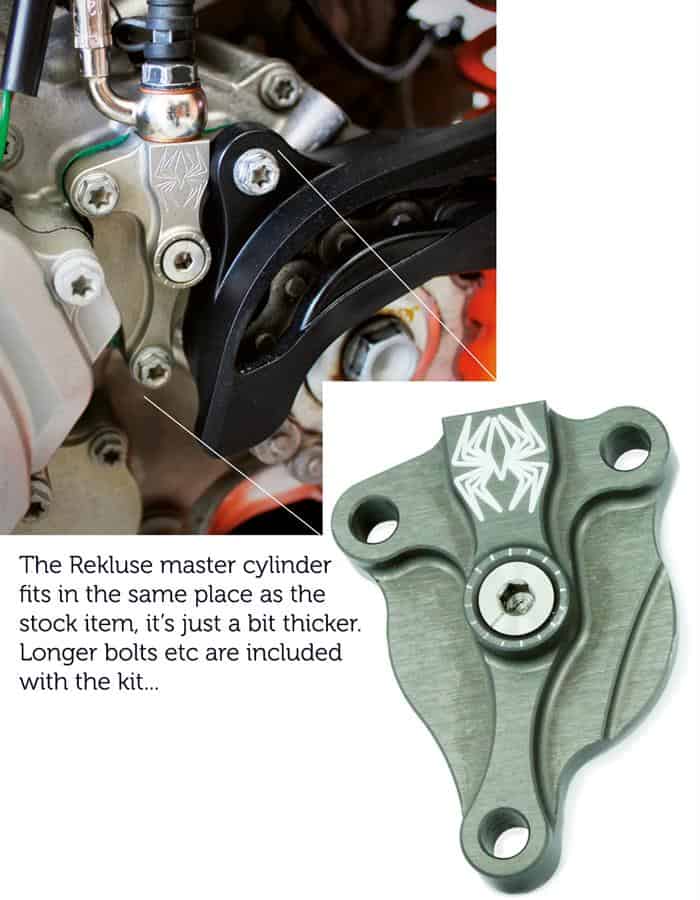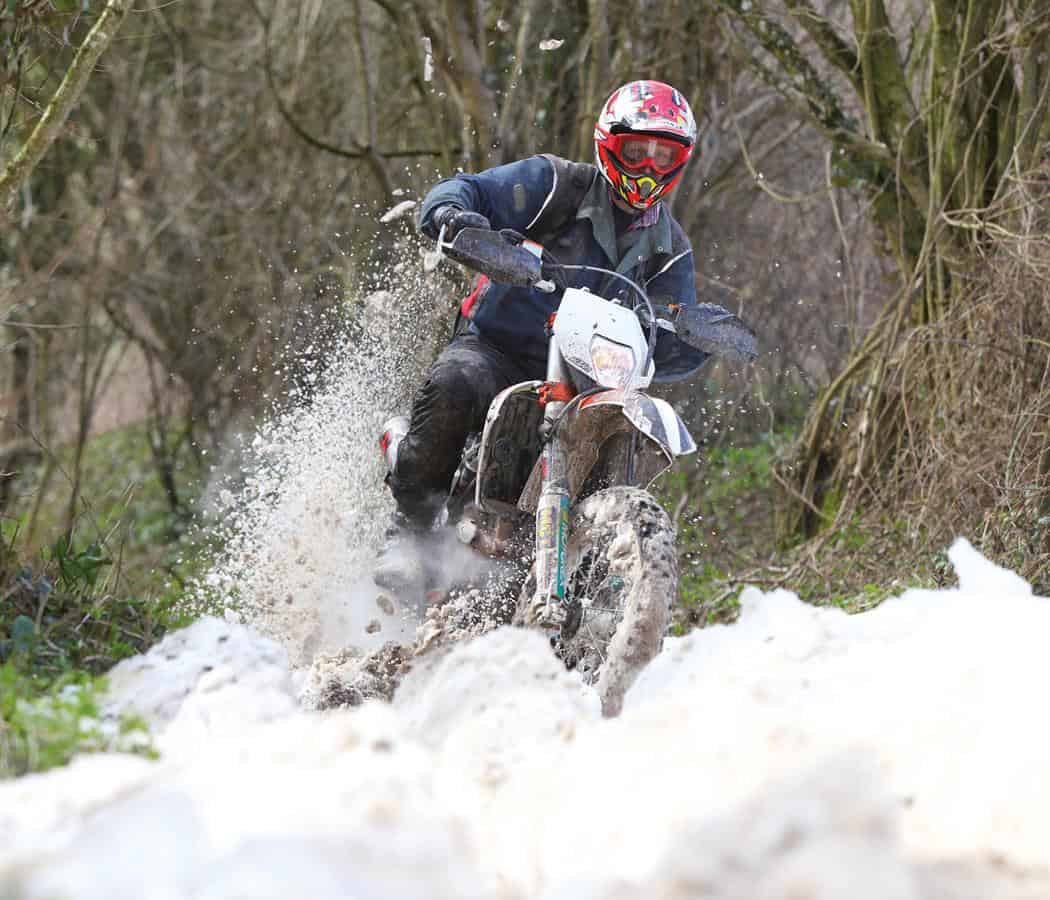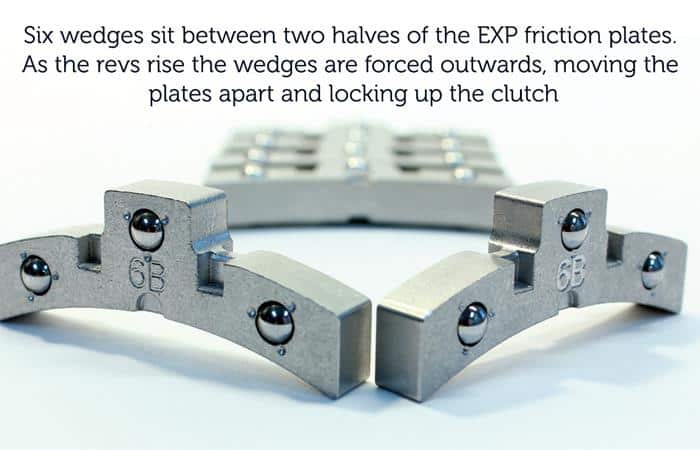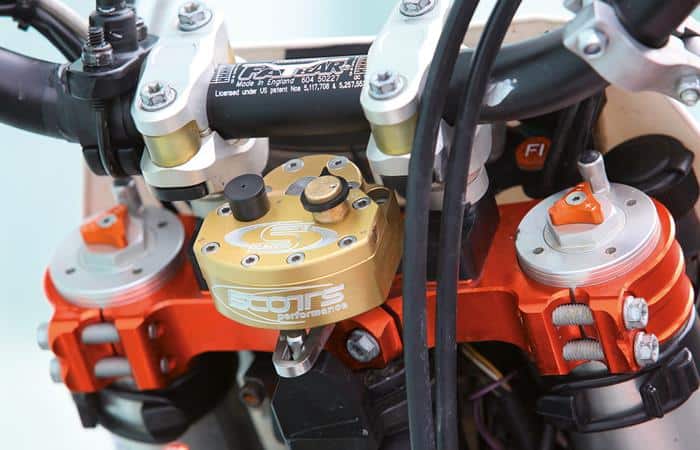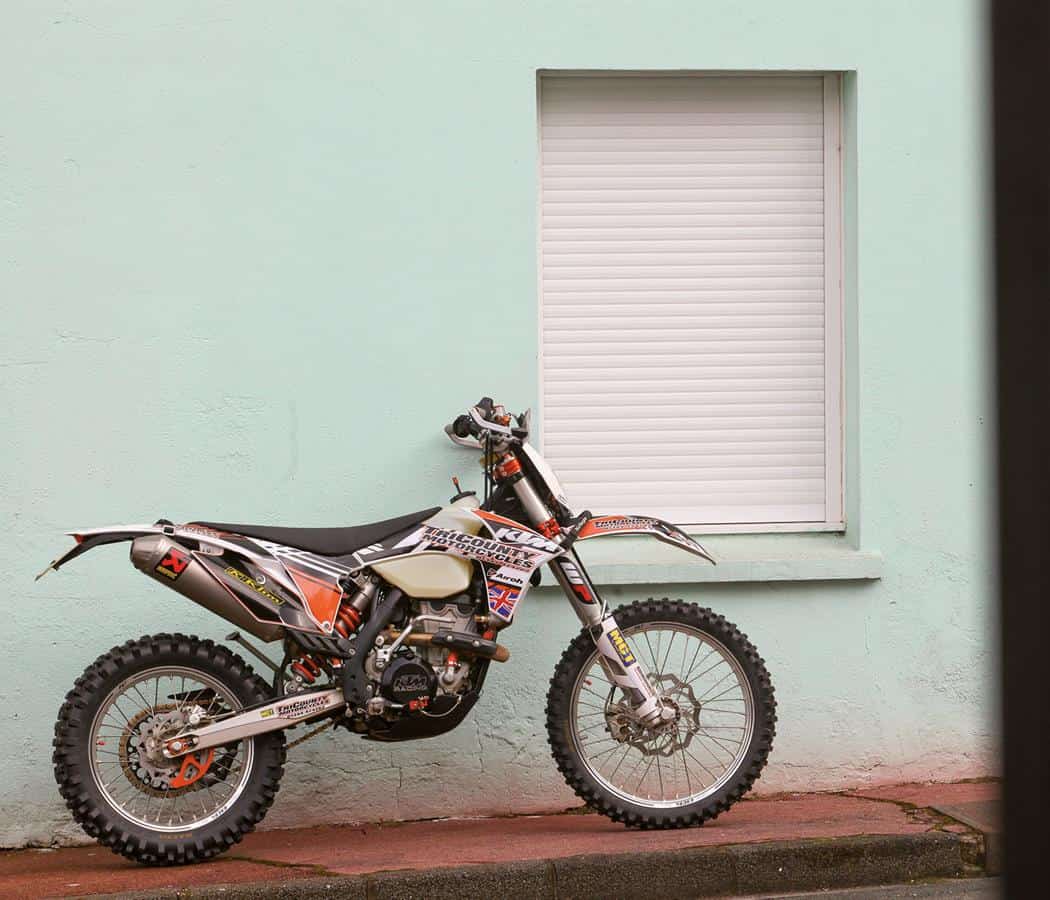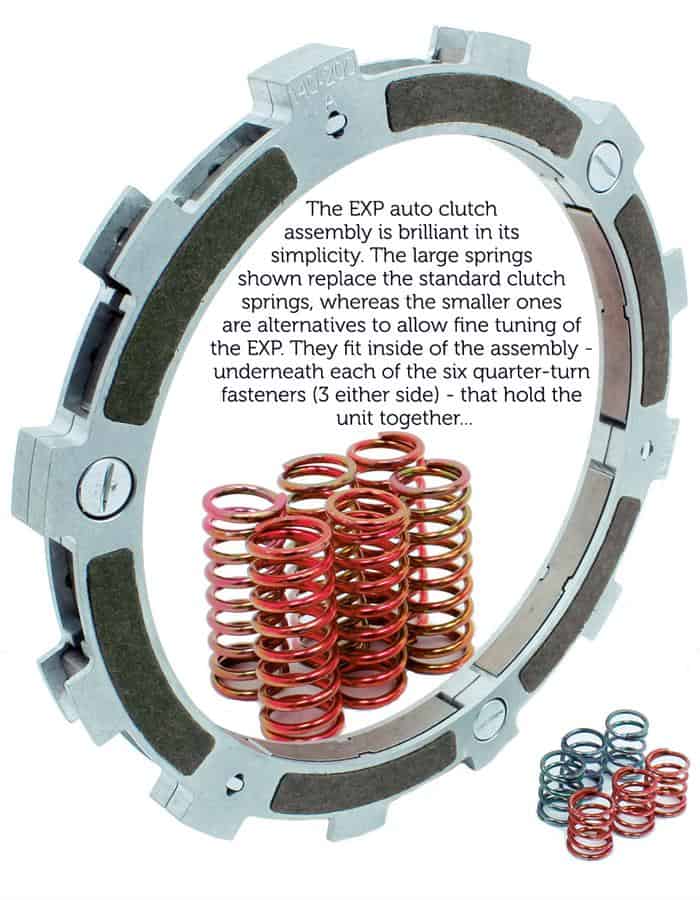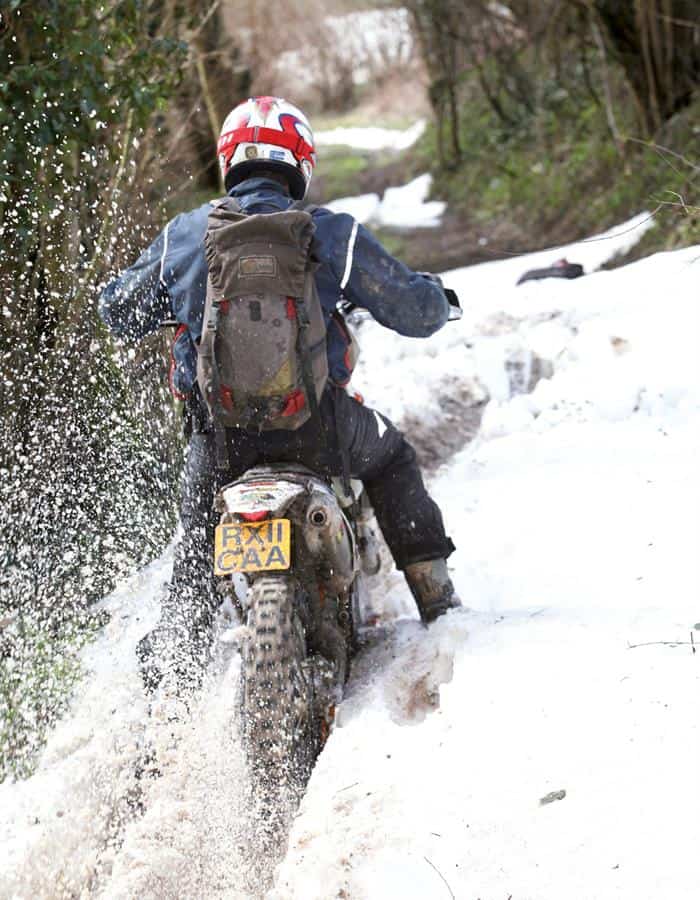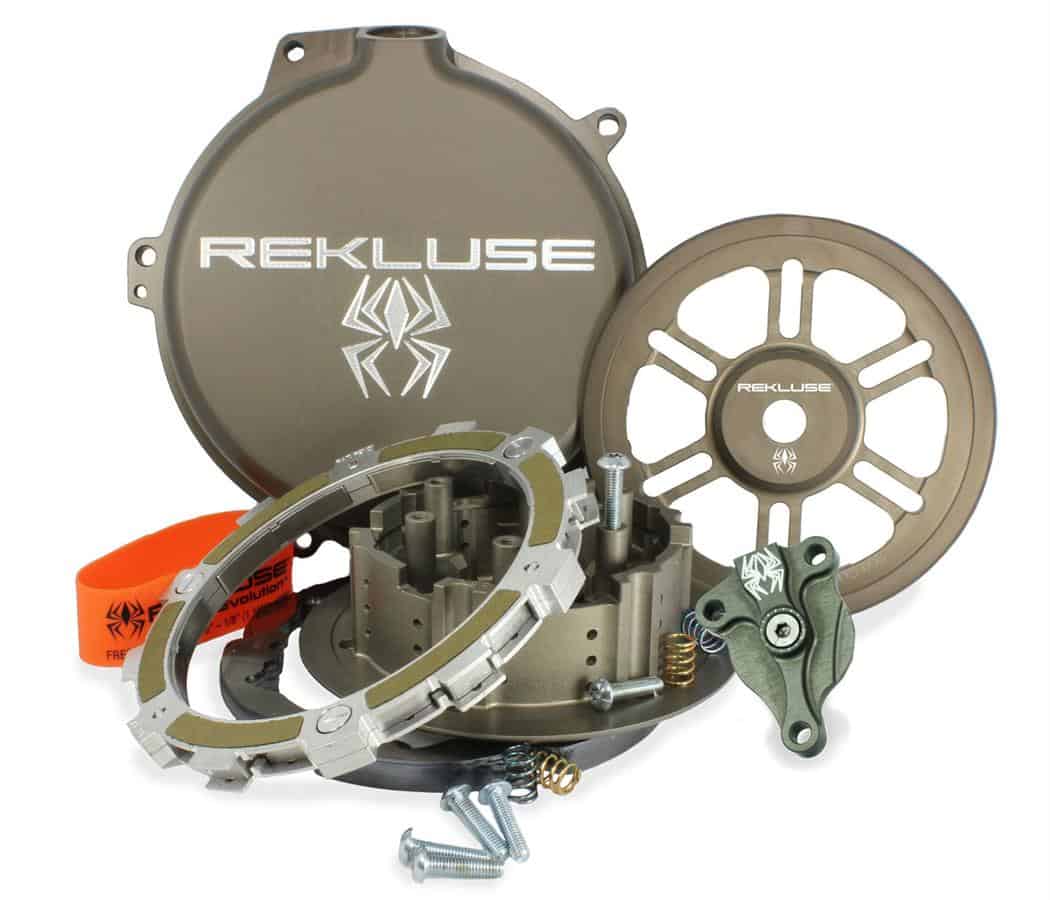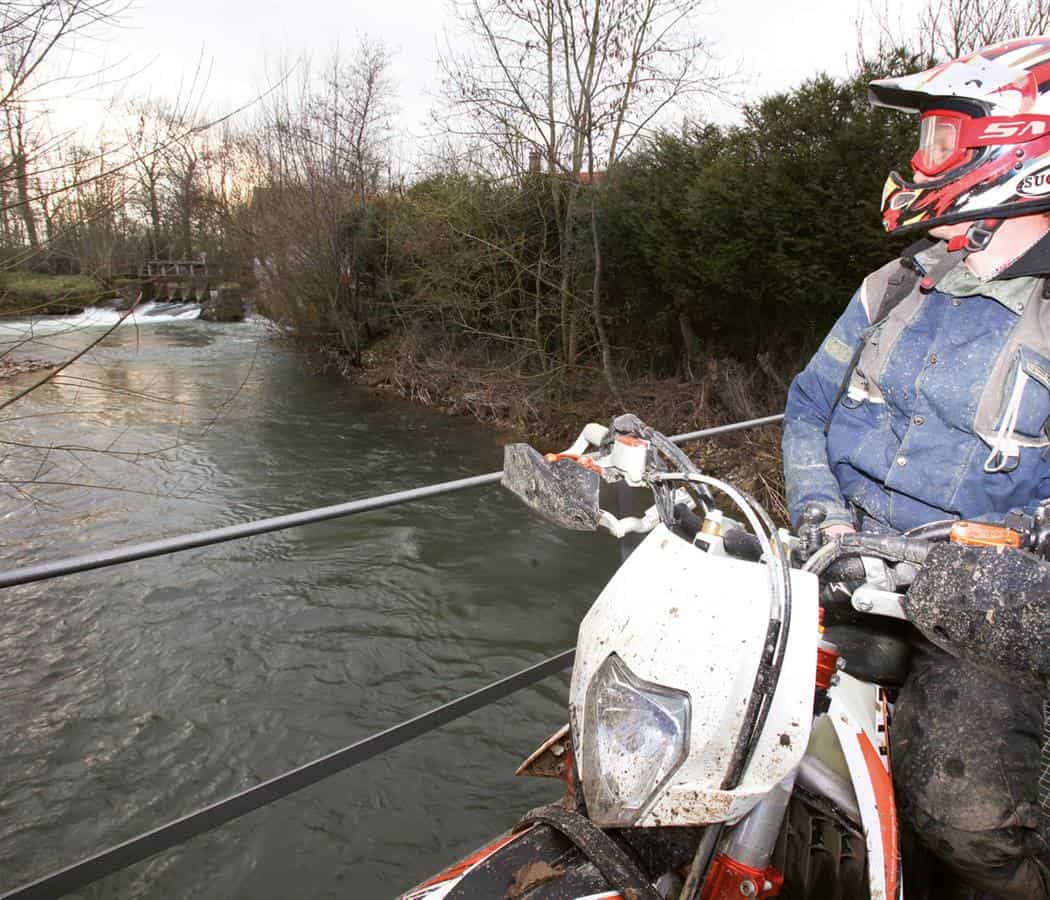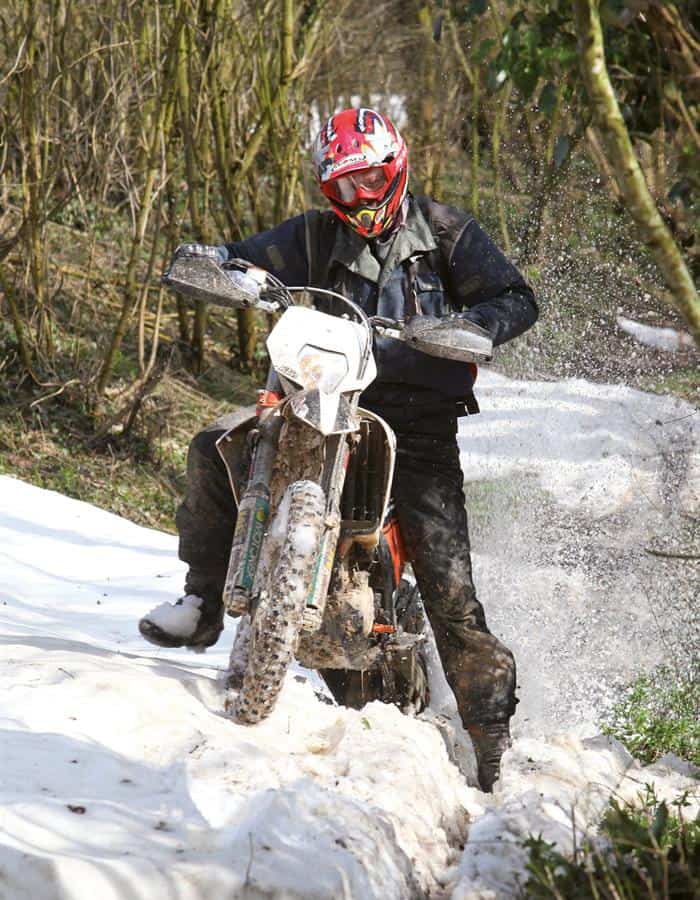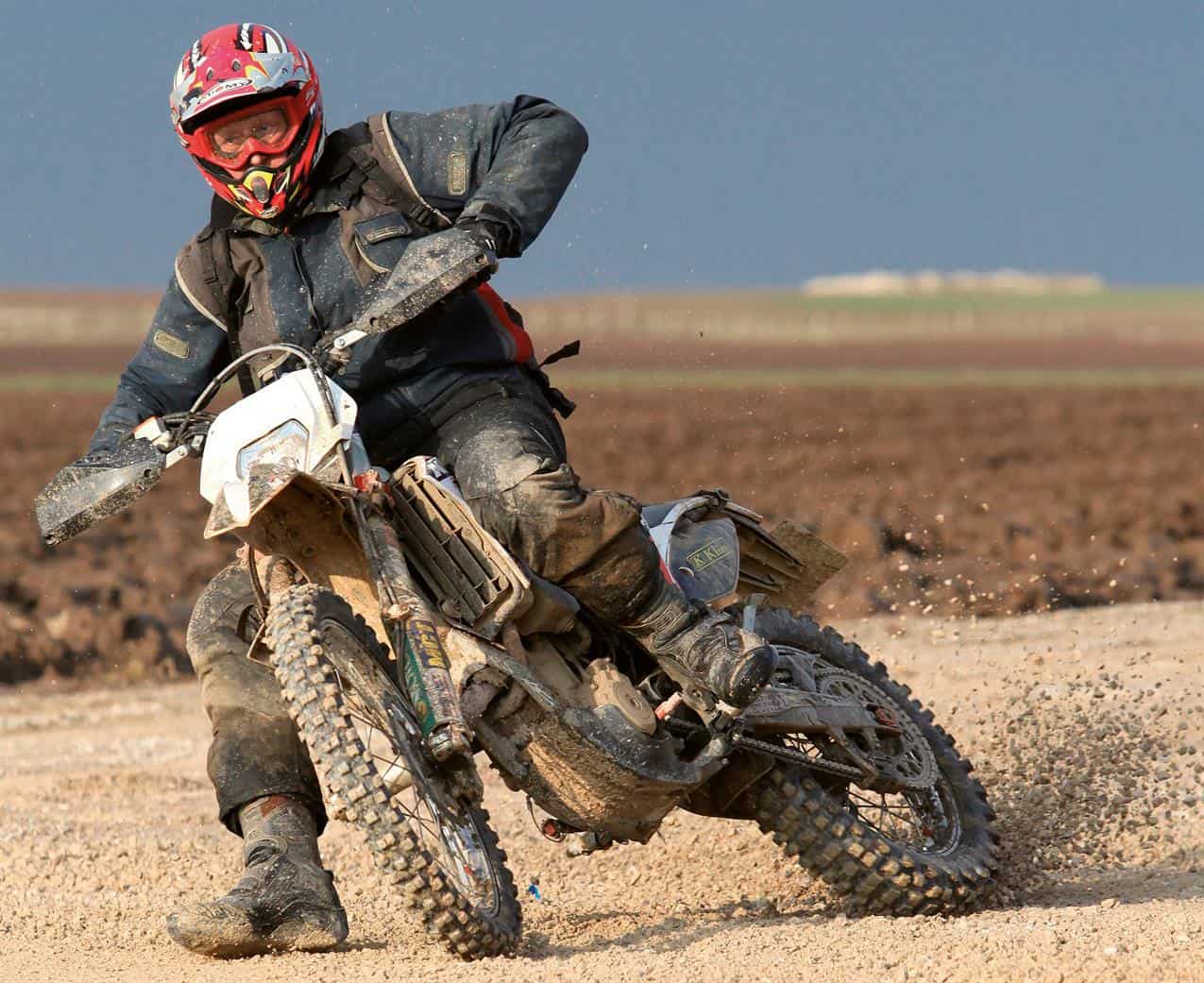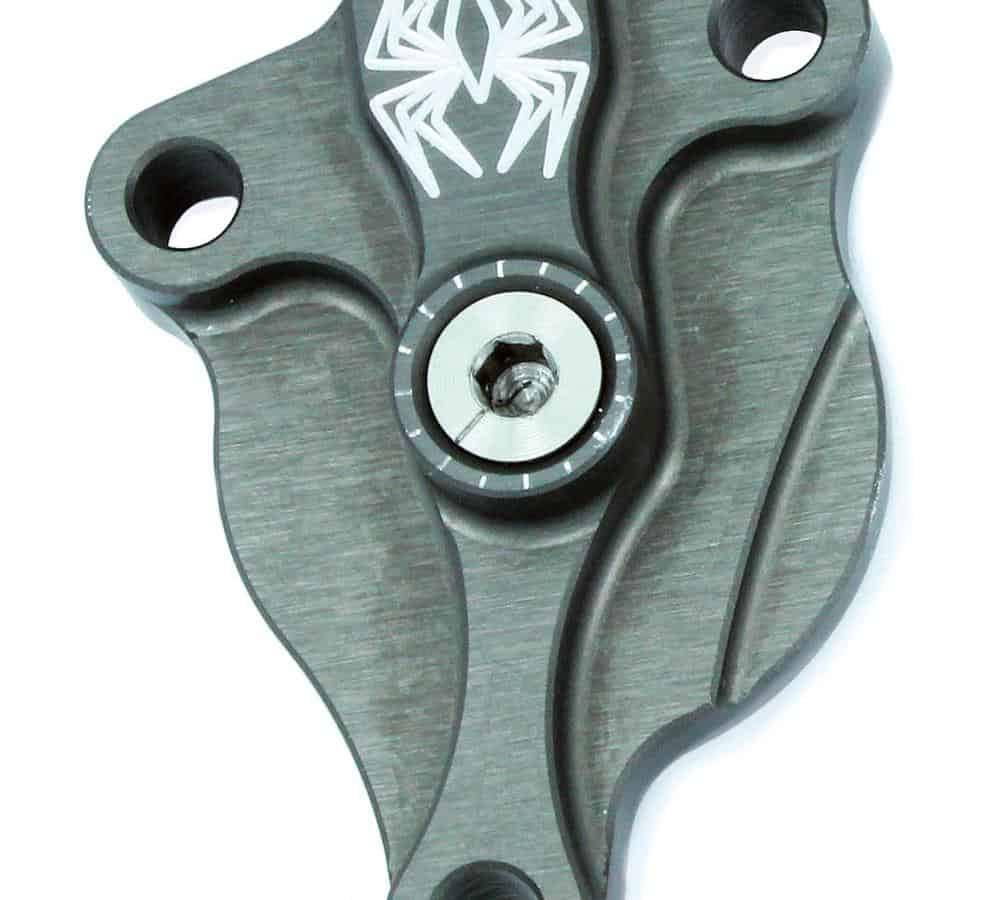The auto-clutch has evolved to the point where it’s now very affordable, simple to fit and easy to maintain. So should we all be thinking of fitting them to our dirt bikes? RUST headed to the trails to find out…
Let me tell you as a bike journalist of way too many years experience… it was the weirdest sensation ever. Arriving at a T-junction with a busy main road and not reaching for the clutch lever. All your instincts tell you that you need to grab the clutch or else one of two things is gonna’ happen. Either the bike will stall and chuck you over the bars into the path of oncoming traffic; or it’ll continue to push you forwards (into the path of oncoming traffic). Either way you’ll be playing traffic ping-pong and your gravestone will doubtless read: Here lies the bloke who ignored all his instincts. Ha!
The reality is far less dramatic… As you approach the junction on a trailing throttle you have engine-braking in the conventional way. You brake to a halt. At the last minute the auto-clutch disengages the drive, and the bike idles. Then when there’s a gap in the traffic, you twist the throttle. The auto-clutch instantly and seamlessly re-engages the drive and away you go. End of story.
Snow Patrol
It was one of those plans that should have had no realistic chance of ever coming together in time, but somehow managed to all fall nicely into place. A day trip to France – early start, round the M25, catch the shuttle, offload the bikes 40km south of Calais (three of us in total), and head off on the trails following an old road-book borrowed (as a one-off favour) from RUST columnist Chris Evans at Sport Adventure. Chris used to run trips in this area, but stopped coming here when a number of the trails were stopped-up and he couldn’t be certain of a continuous route.
No such trouble for us because whenever we found a closed trail we simply skirted around it and picked up the roadbook later on, we had no schedule to adhere to, other than being here to test the bike. Of much more concern were the conditions on the ground. A major dump of snow ten days beforehand had – we assumed – long since melted.
But as we arrived in France we were met by a mixture of sodden ground and windblown snow, which had disappeared from the fields and piled up in the sunken lanes between the banks. Drifts of 6-8ft high filled many of the tracks and pretty much every trail we rode had deep snowdrifts to contend with. Good job then that one of the claims of the Rekluse EXP auto-clutch is that it helps improve traction in slippery going. I was going to find out in a very practical way if they could substantiate that claim…
Auto Erotic
Does anyone actually need an auto-clutch on their dirt bike? Obviously not… it’s a rhetorical question. But a sizeable number of riders are buying and fitting them now, so there must be some discernible benefits. The makers claim they offer improved traction, easier riding, less fatigue, faster cornering and virtually no stalling – just the sort of things you’d want on the dirt – so we felt it was time we investigated properly. If anything can improve your ride and make you feel more confident on the bike then we wanted to know about it… And tell our readers about it too.
But before we go into any detail about the product, it’s worth mentioning (just to clear up any confusion) that although this is an auto-clutch, it doesn’t mean your bike will henceforth have an automatic gearbox like a twist-and-go scooter or an automatic car for instance. The Rekluse only affects the action of your bike’s clutch and not the rest of the transmission. So you still change gears in the conventional way – with or without the clutch lever – and you still need to select the appropriate gear for the conditions.
And a couple of other myths we want to bust early on are that firstly… auto-clutches don’t allow for engine-braking. They do. For the most part the clutch remains ‘locked-out’ and feels exactly the same as a conventional clutch when you’re decelerating or on steep downhills for instance.
And finally the old chestnut… you can’t bump-start an auto-clutched bike if you get stuck out in the wilderness without a battery or a kickstart. Well yes you can. Twisting the external adjuster, locks-out the auto-clutch in seconds, so then you bump-start your bike in the normal way okay?
Clutching at Straws
The Eagle-eyed amongst you will probably recognise this bike. It’s the same 2012 KTM 350EXC – bored out to 365cc – that we took to France this time last year when we rode the two-day Grappe de Cyrano enduro https://rustsports.com/metal/enduro/2012-ktm-350400exc-f-at-the-grappe_5799.html . It’s wearing a new set of white graphics in the livery of Tri-County motorcycles – the dealers that built it – and of course it now has the Rekluse EXP auto-clutch fitted for the purposes of this test, but otherwise it’s the self-same machine.
We chose this bike in order that we had a ‘control’ to judge things by… a familiar starting point from which to assess any improvements – if indeed there were any – to try and weigh-up the practical benefits of an auto-clutch. It was a machine we were used to riding and one we had plenty of experience with.
Interestingly, one of the comments often levelled at magazines by readers is that we generally only get to try out brand new machinery direct from manufacturers, and rarely follow-up a story on a modified bike. What happened next…? Did it go BANG… Was it problematic… Fragile… Unsellable? Here was our chance to redress the balance on that score too.
This bike was built in the winter of 2011 using a brand new 2012 350EXC fitted with a Vertex 2mm oversize piston kit, taking bore diameter up from 88mm to 90mm and giving the engine a true displacement of 365cc. Not a sizeable increase in terms of overall capacity, but when you combine that with the gas-flowing work to the cylinder head, it’s enough to give the Tri-County machine a subtle boost in usable torque.
The stock 350EXC is not really known for its torque – its performance, yes. Its rev-happy motor certainly, and for the way it manages to combine a fabulously potent engine with a lithe and manageable chassis making it perhaps the best four-stroke enduro bike around right now. But you wouldn’t call it especially torquey. It’s got enough, and no more.
The 365 is subtly different. It adds torque, improves tractability and enhances an otherwise great machine. I’ve said it before but the 350 doesn’t actually need improving, but that’s not to say you can’t set out to try and make it better. That’s what Clive Hoy did when he originally put this machine together more than a year ago, and since then it’s been doing the business on a weekly basis as the ‘lead bike’ for his ride-outs from his Bracknell-based dealership in Berkshire.
Not only has it been used at least once a week for the past year (a lot more hours than the average dirt bike gets), but it’s also been in the hands of numerous punters who wanted to test it out for themselves. Twelve months on I can report that the bike is still on its original Vertex piston and rings, and aside from wheel-bearings and regular service items, has not received a single replacement part. Testament to the quality of the workmanship and parts that went into building it, and proof that specials need not be any more maintenance-hungry than a stocker.
Nursing a Semi
Rekluse automatic clutches have been in existence since 2002/3 when the very first system (designed by founder Al Youngwerth in his garage in Idaho), came onto the market. Originally designed to be used without a clutch lever, in 2005 the Rekluse z-Start Pro was the first auto-clutch to give the rider full manual clutch override capability, whereby you retained a clutch lever on the bars – should you wish to use it. [Always useful if you have a bike with a sticky throttle].
Over the past ten years we’ve ridden countless bikes fitted with auto clutches (both with and without clutch levers) and know numerous riders – racers and trail riders – that swear by them. Pretty much all of them have said the same thing to us: ‘It’s great to use but takes a bit of setting up and requires more maintenance and adjustment than a regular clutch.’
And to be honest that’s always been a stumbling block for us up till now. We loved using them, but hated the idea of adding something that requires careful set-up with a feeler gauge and then regular and constant maintenance. And if you saw the array of ball-bearings and complicated components in the original auto-clutches, you had this horrible feeling of what-if… What if I fitted it wrongly and one of those ball-bearings escaped and went walkabout in my bike’s clutch housing!
But all that’s changed with the introduction of the new EXP auto-clutch, which is an entirely self-contained item that looks like a big fat friction plate and which simply sits in place of a bunch of regular clutch plates in your bike’s clutch housing. It really couldn’t be simpler to install, you undo the clutch cover, remove the pressure plate and take out the requisite number of plates. Then you simply drop the EXP in (it’s the same shape as a normal clutch plate just fatter), reinstall the pressure plate using the supplied clutch springs and fit the clutch cover back in place – and that’s the hard bit done!
The only other thing required is the set-up. On bikes with cable-operated clutches the set-up is done at the lever by adjusting the cable (simply follow the instructions in the packaging, or better still, watch one of the short explanatory videos on the Rekluse website). On bikes like the KTM with a hydraulic clutch, the best way to set it up is to use the aftermarket Rekluse clutch slave cylinder which has an external adjuster built-in.
This simply fastens in place of the stock item using the existing three bolts and once bled, it’s just a matter of turning the adjuster screw on the outside (using a 4mm Allen drive) and then testing the results. A few minutes spent adjusting it and you’re ready to ride…
Life’s a Drag
Clive had warned me that just like any clutch, the Rekluse could drag just slightly from cold until the oil had warmed up. No problem, you expect that on any bike, so I started the bike in neutral, let her idle for a couple of minutes and then clonked her into first gear – using the clutch at first. Once the oil was warm I let out the clutch (at idle) and the bike simply sat there. Thereafter it’s a matter of twist… go… shift… and go again. Once warmed up the bike can be started and stopped in gear with no noticeable effect on the starting.
Ridden in a conventional fashion – ie letting out the clutch to get going, and pulling in the clutch as you come to a halt etc – you’d be hard pushed to notice any real difference between the EXP-equipped bike and a regular one. It reacts pretty much the same way you’d expect a normal clutched-bike would to any given situation. You can spin the rear wheel, pull wheelies, dump the clutch to get instant drive etc in exactly the same way as you would with a conventional clutch.
There are a couple of minor differences however; clutchless changes (on the way up the box) are definitely smoother. The EXP momentarily transitions the change of ratio so that the gears slide home easier, though downchanges feel exactly the same as normal.
The main difference is that this bike won’t stall. Set off in too tall a gear, drop into a rut at speed and shut the throttle, or simply open the throttle too vigorously at the wrong moment – ie the sort of situation that might cause a conventional bike to cough-stall perhaps (especially a carb-equipped one) – and it simply refuses to stall.
Instead, the EXP takes care of things using a limited amount of clutch slip. I never stalled the bike all day. Not once! But not stalling is really only one of the minor benefits of the auto-clutch… the real difference comes in the riding experience.
Cold Comfort
With an outside temperature of barely 4ºC, the occasional flurries of sleet falling on sodden ground, and a mixture of chalk and clay beneath our wheels, we set off into the French countryside. The first trail was slippery and waterlogged at the beginning but within a few hundred metres there was a huge bank of snow that had to be breached. I wasn’t sure if it was soft or solid, so I shifted my weight back, dropped a gear and piled in.
In fact it turned out to be both: solid on the outside and then when the wheels dug through the crust, they quickly sank into the depths of the snow. The revs rose as the KTM fired a roost of snow 20 feet into the air and it began gently falling back to earth like Christmas at Santa’s grotto. The bike slowed to walking pace (despite being in second gear with the rear wheel spinning) but kept clawing its way inexorably forwards, blowing out snow behind me like those snow machines at ski resorts.
A few seconds later we shot out of the snow bank with the engine still howling and the rear wheel spinning wildly. I snapped shut the throttle and remembered not to touch the clutch. The engine simply idled peacefully and the bike and I rolled to a halt as we waited for the other riders to arrive. Wow.
Setting off again afterwards, this time without using the clutch, I just twisted the throttle (gingerly at first) and the KTM pulled away cleanly. Pretty quickly I realised that you can be much more brutal with the throttle and the EXP simply takes up the drive and accelerates you forwards. In fact the brisker you are with the throttle the more seamlessly it all works.
It’s a ridiculously weird sensation because you don’t have to feed in the clutch and feel for grip, all you do is twist the throttle and moderate the revs. Of course pulling away on the flat is simple on any bike, but the beauty of this system is that you need never think about (or worry about) the clutch whatsoever. No matter if you’re in mud, on a slippery surface like snow or gravel, or even just trying to negotiate a small bank or rut. Forget the clutch just twist and go. The hardest thing to overcome is your own self-doubt.
Rolling Thunder
The countryside around Calais is what you might term rolling… There are no big hills as such, just gentle ascents and descents. However our ride was turning out to be far from gentle. The second lane we reached was completely snow-bound, there was nothing for it but to head up the bank (a steep climb out), circumnavigate the snow and then drop back in, back down the bank. I had wondered (until I tried it for myself) whether the claimed engine-braking would materialise. It did.
The funny thing about the auto-clutch is that most of the time you don’t actually notice it. It’s working away in there and you can’t feel it, or feel like you need it, but it’s actually helping you out lots of the time – aiding grip and preventing stalling, especially when the going gets technical.
The second and third lanes were mercifully snow-free, but the following one had a huge bank of snow in the middle and no obvious way round it. I piled in with the engine revving hard and the KTM clawed its way up the bank of snow before finally digging in just at the top. No clutch control needed, I simply rocked the bike over the top and then opened up the throttle again. Once again we had drive and the KTM dug its way out.
Could I have done the same without the auto-clutch? Yip… but the EXP just made the job that little bit easier. For example, both the other bikes I was riding with stalled during the same manoeuvre – neither of them had working electric starts either!
A few miles of roadwork confirmed that the EXP works just as well on tarmac as the dirt and again, aside from pulling away and stopping (without using the clutch) you don’t really notice its effects at all. It’s worth mentioning that with this version there’s a slight increase in the effort required to operate the clutch lever, but obviously that’s offset by the fact that you barely touch the lever. In fact you could ride all day and never have to use the clutch lever if you wanted, so it’s not such a big deal
Rekluse point out that there are versions of their clutch available that offer an identical lever feel to stock, but these are more expensive and more complicated in terms of fitment, and in my opinion these facts outweigh the simplicity offered by the EXP. When the ride was over I had no fatigue in my clutch hand at all as I’d barely used the lever all afternoon.
Slip n Slide
The other major time that the auto-clutch comes into play is when the conditions and levels of grip are changeable – precisely the conditions we were testing in. In these circumstances the clutch is adjusting the amount of torque fed through to the gearbox to try and maintain maximum grip. You can feel this if you change up too quickly for instance, and simply sit there in a high gear with a large dose of revs dialled in. Obviously this is not the way the auto-clutch is designed to be ridden, but it does demonstrate the effect it has.
Ridden like this the clutch will partially slip until the point at which engine revs are matched by the track speed appropriate for that gear. This happens in all gears of course and with the appropriate gear selected it’s precisely what the auto clutch is designed to do. In other words the clutch is allowing tiny slippages to occur in order to maintain ideal drive.
It’s no different to what pro-riders do when they’re racing. Watch one of the pro-riders using his clutch at an event like the Tough One extreme enduro – especially the pros with a trials background – and you will see that they maintain one finger on the clutch lever at all times. This allows them to momentarily dip and slip the clutch, moderating the power and feeling for grip. It’s not harmful to the clutch in any way, in fact it’s precisely what the clutch is designed to do. Tiny slippages like this won’t harm the clutch plates one bit, providing you’re in the appropriate gear. What destroys clutch plates is lots of heat and continuous slipping.
Of course it’s possible to do that with the EXP. If you were to stick the bike in top gear for instance and simply pull away and ride all day in that one gear with large handfuls of throttle at low speeds then you’d be asking for trouble. The auto-clutch is a smart piece of kit but it can’t account for eejits.
But the ideal way of using it is to ride your bike completely normally (except for operating the clutch lever), and use the auto-clutch as a rider aid to help you find grip, help pulling away cleanly on a hill start for instance, and help make the ride even less of a hassle.
If you’ve ever come back from a horribly muddy ride or race with your left hand cramped up because of all the time you’ve spent trying to modulate a heavy clutch, then suddenly you will get a feel for why this product is such a great idea. And so far we haven’t even touched on the possibilities of having the rear brake up on the left bar – bicycle-style.
At the Bar
I know when I talked to a couple of riding mates about this bike, they all wanted to know whether it had the handlebar-mounted back brake. In fact it didn’t, but that’s not to say it won’t have in the future. Knowing the bike’s owner like I do, I suspect it’s only a matter of time. Of course mounting the back brake up on the left bar (you still keep the pedal as well) is the next obvious step in terms of improving your machine.
Think about it – not only is a gloved hand much more sensitive in feeling for the point of lock-up than a muddy MX boot, but it also allows you to brake on slippery right handers when your right foot is sticking out into the turn. And of course because you don’t have to operate the clutch mid-corner in order to feel for drive, you can let your hands do the braking and leave the auto-clutch to figure out the drive. Brilliant.
Not all the lanes we rode were snowy. After a brief stop to thaw out over hot chocolate in a little café bar, we spent most of the afternoon charging along slippery muddy lanes. In these conditions the 365 is such a great bike to ride. It’s light enough to let you flick-in quick direction changes – avoiding the worst of the ruts – but stable enough to keep the front wheel planted when you need it.
The extra rumble of torque is ideal as it lets you roll on and off the throttle without requiring too many gearchanges, yet there’s always power available should you need it. It may only be my perception, but the auto-clutch definitely makes the bike feel slightly less powerful than it really is. That’s presumably because it tames the power spikes and momentarily softens the delivery.
That’s no bad thing of course because it lets you ride harder than you usually would. I’ve ridden both two-strokes and four-strokes fitted with auto-clutches and both seem to work equally as well, but in general I’d say they do their best work in more powerful machinery because the slight calming effect is more useful.
Right at the end of our ride we came across a track that had been graded by earth movers, producing a lovely sweeping gravel corner that just begged to be attacked. Knock it down a gear, pitch the bike in sideways and pour on the coals… and the 365 responded with a lovely progressive slide, that could be held in a drift for the entire turn. The Rekluse may well help the bike hook up in tricky conditions, but it was pleasing to know it won’t do anything to spoil your fun…
Pros and Cons
So what of the downsides to the EXP? Well obviously there’s the cost to consider. This EXP clutch unit itself , ncluding the adjustable slave cylinder the whole thing will set you back around £550. That’s not bad for a revolutionary change to the way your bike operates. If you don’t like it, well you can always take it out and return the bike to stock. The whole transformation can be done in well under an hour.
There’s still a little extra maintenance to be done over and above what you’d expect with a regular clutch. Rekluse reckon you might need to tweak the adjuster (go through the set-up) every two or three rides (big deal), and the parts will eventually begin to wear after hundreds of hours use, but that’s the same as any moving part.
Overall then, there does seem to be very little to dislike about the EXP, but lots to make you smile about. When it comes to racing, perhaps you could argue that anything which takes away from the rider’s control isn’t necessarily an advantage. And I would concede that the very best riders will get less out of an auto-clutch than the average Joe.
So are you a top rider reading this, or are you an enthusiastic amateur? Because believe it or not this experience completely changed the way I view the Rekluse auto-clutch. No longer a novelty item, the simplicity and one-piece nature of the new design, the fact that it can be swapped in or out so easily, and the extra level of fun it offers just opens up a whole novel world of stall-free and fun dirt bike riding.
Do I need one? No… But would I buy one if I had the money…….?
Definitely!
Thanks to: Clive at TriCounty Bike Shop (01344 424282) for allowing us to use his KTM 365EXC for this test. TriCounty are REKLUSE retailers and can install and maintain Rekluse auto-clutches as well as build you a one-off special like their bike. See www.tricountybikeshop.co.uk for more details. Also thanks to Richard Bott for his help with this feature and Rekluse USA for supplying the technical images.
How it works
Like the very best ideas, the EXP system is amazingly simple but quite brilliant in its conception. It essentially consists of a pair of specially designed friction plates, sandwiching a set of six moveable wedges. Each wedge is able to move a few mm thanks to a set of three ball bearings contained within it – a pair of pegs prevents the wedge from moving too far. A spring on each of the six quarter-turn fasteners that hold the whole thing together, pre-loads the plates… forcing the wedges inwards towards the centre. As engine revs rise and the clutch spins faster, centrifugal force pushes the wedges outwards, overcoming the resistance of the pre-loaded springs and forcing the clutch to lock-up. Because of the way it’s been designed, each EXP auto-clutch is fully tuneable… By adjusting the weight of the wedges (heavier and lighter wedges are available) you can alter how hard the power ‘hit’ comes in, and by altering the spring weight (again different weights are available) you can adjust where and at what RPM it begins to engage.
Fully rebuildable using replacement parts, each of the constituent components can be changed should they begin to wear. But ridden correctly (ie not constantly labouring the bike in too high a gear, or overheating the oil), the Rekluse clutch should outlast the OEM components.
Second Opinion
An automatic clutch? On a Dirt bike? Its not like it’s a step-thru and you’re using it to deliver pizzas. Every one knows that a dirt bike requires that extra level of control that only a clutch can provide.
Or does it? As usual I’m wrong. Out for a day’s trail riding the auto clutch is in my humble opinion, a real advantage. Unlike test rider Si (who got there in the end) I adapted to it almost straight away. I loved the way you could just take off on any surface with as much or as little throttle as you wanted.
The best bit though was when the going got a bit technical… If for instance you found your self stopped in a bog (or on this day a snowdrift) with the back end starting to sink – you could hop off the bike, lift the back wheel out of its rut onto firmer going, and then goose it again. The whole operation could be performed without feathering the clutch lever, fiddling the bike into neutral or having to hold the clutch in at all. All of which involves keeping your left hand on the bars.
I only tried it trail riding but have no doubt that the above advantages would translate over to racing. This device could make all the difference in a wet and technical event. Especially when you are knackered. I am not so sure it would be of as much help to an expert rider. They tend not to cease forward progress with the depressing regularity of your average Clubman like me.
Nonetheless I’m reliably informed that some top riders are starting to use auto-clutches. For the rest of us (and statistically that includes most of you reading this) here is a great improvement for an affordable price. Forget the custom hubs, personalised graphics or the trick exhaust, this thing will actually make your bike better. Richard Bott
Mr Rekluse
Al Youngwerth is the brains behind the Rekluse brand which now employs 40 people and operates from a purpose-built state-of-the-art manufacturing facility in Boise, Idaho. The 47yr old spoke to RUST about how the auto-clutch system came into being…
‘I’ve been a dirt bike nut since I was a kid. I got my first dirt bike aged 8yrs old and have been riding ever since. Back in 2002 after the Honda CRF450R came out, I bought one and rode it on the trail, and man… that thing was hard to ride. I was always looking for a way of making it easier to ride the miles of single-track that we have out west. And I came across a product called the Rev-Lock auto-clutch. I bought one and fitted it to my CRF and sure-enough it was excellent, but unfortunately within a few months I’d broken it. I spoke to a few trail riding buddies of mine who had also tried the Rev-Lock and they had had the same experience as me. They reported that the product was great but it was fragile and kept breaking. I tried talking to Rev-Lock about it, but in the end they got sick of me pestering them and stopped answering my calls. So I decided to design my own auto-clutch. I worked out how it should go, drew it all up and got a local machining shop to manufacture it. It used a system of ball-bearings and ramps. I got lucky and guessed the angle of ramp needed at 14 degrees, and this turned out to be exactly right. Experimenting afterwards I discovered that 14 degrees works, but 15.7 degrees doesn’t. It was a lucky guess, but sometimes in life you need a bit of luck. That was the start of Rekluse…

